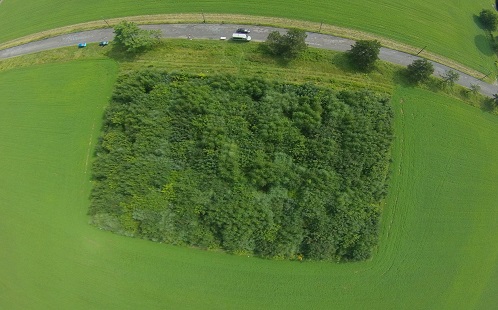Strength in diversity: research finds a mix of tree species is better for overall growth

New international research conducted in collaboration with Western Sydney University's Hawkesbury Institute for the Environment demonstrates the beneficial impact of planting a diverse mix of trees rather than opting for monoculture plantings.
In experimental plantings of young temperate trees, the researchers found that the trees in diverse, mixed-species plantings were able to make much better use of light to produce more growth than equivalent trees from single species.
This finding is important in revealing how trees respond to others in the community, and how different types of trees are able to capitalise on opportunities and gaps to collectively enable every tree to produce more wood.
The research was conducted by an international team including researchers from Western Sydney University, University of Minnesota, and Université du Québec à Montréal. The findings have been published in the journal Nature Ecology and Evolution.
Co-author of the study, Professor Peter Reich from Western Sydney University's Hawkesbury Institute for the Environment, says much like any other organism, any particular species of tree has certain attributes that it has evolved to perform well in its environment.
"This might be, for example, an ability to grow a broad canopy with leaves at the end of long branches to grow at the top of the forest, or it might be a tall, straight architecture that allows it to grow upwards and find a light pocket. It might also include features such as a canopy spread that faces the sun in an east to west pattern so that it can ensure that most of its leaves get sunshine all day long," says Professor Reich.
"These traits enables trees to become masters of certain conditions and when two species have canopy architecture that best complement one another – by filling in gaps more uniformly – the pair grows better on average than they would alone."
Professor Reich says this new study also shows that in order to cope with competition, trees of different types alter their architecture to take the best advantage possible of gaps when growing together with other species.
"So not only do those species with complementary architecture thrive in pairs, but this is especially true when they are also able to shift their crowns to make them even more complementary – that is, to harvest even more of the incoming sunlight," he says.
"This richness of features is evident in the dense greenery that we see when we look at a forest – a diverse mix of tall trees, understorey species and intermediate species each combining features they evolved with the ability to change in response to events such as branches breaking off or taller trees falling over. Within a forest ecosystem, this diversity has been shown to offer much greater potential for wood and biomass production than if trees are planted only with others of the same species.
"In our research, we saw how trees such as pine and birch formed different styles of canopy yet each tailors their structure to tightly fit the canopy together when growing jointly to almost completely fill the canopy with leaf area.
"Much like a successful research team, it's all about building on the strengths of your neighbour and contributing your own specialisation to reach a great outcome!"
Professor Reich says the findings provide a new understanding of the importance of diversity in ecosystems as the world looks towards long-term resilience and productivity.
Previous research from Western Sydney University also demonstrated the importance of biodiversity in ensuring that the functions of forests that we rely on – carbon capture, wood production, slowing water runoff in catchments and oxygen production – are much higher if we ensure that species diversity is maintained.
For more information, please see:
Williams, L. J., Paquette, A., Cavender-Bares, J., Messier, C. & Reich, P. B. Spatial complementarity in tree crowns explains overyielding in species mixtures. Nat. Ecol. Evol. 1, 0063 (2017).
ENDS.
1 March 2017
Latest News

Opinion: A story of trauma, hope and regaining control, Nayika: A Dancing Girl is soul-stirring dance theatre
The complex and grappling issue of violence against women takes centre stage in the soul-stirring solo dance drama Nayika: A Dancing Girl.

Western Sydney University announces Professor George Williams AO as new Vice-Chancellor
One of the nation’s most esteemed and respected university leaders, Australian constitutional law expert Professor George Williams AO has been named the next Vice-Chancellor of Western Sydney University.

Opinion: Do we really need to burp babies? Here’s what the research says
Parents are often advised to burp their babies after feeding them. Some people think burping after feeding is important to reduce or prevent discomfort crying, or to reduce how much a baby regurgitates milk after a feed.
Mobile options:

